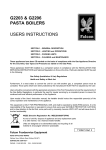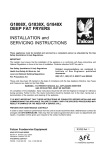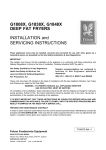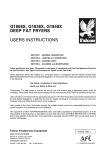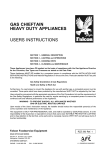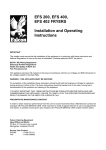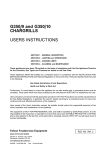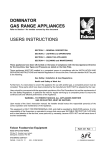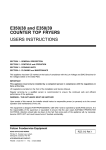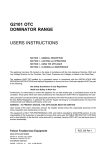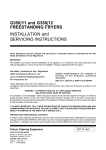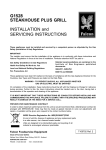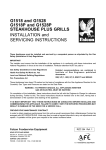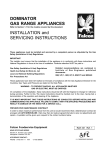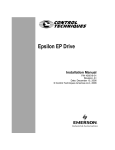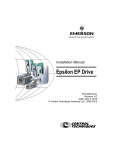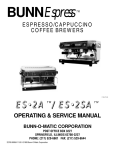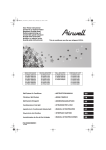Download G2203!Service Manual
Transcript
G2203 & G2206 PASTA BOILERS INSTALLATION and SERVICING INSTRUCTIONS These appliances must be installed and serviced by a competent person as stipulated by the Gas Safety (Installation & Use) Regulations. IMPORTANT The installer must ensure that the installation of the appliance is in conformity with these instructions and National Regulations in force at the time of installation. Particular attention MUST be paid to - Gas Safety (Installation & Use) Regulations Health And Safety At Work etc. Act Local and National Building Regulations Fire Precautions Act Detailed recommendations are contained in Institute of Gas Engineers published documents : IGE/ UP/ 1, IGE/ UP/ 2, BS6173 and BS5440 These units have been CE-marked on the basis of compliance with the Gas Appliance Directive, Gas Types and Pressures as stated on the Data Plate. WARNING - TO PREVENT SHOCKS, ALL APPLIANCES WHETHER GAS OR ELECTRIC, MUST BE EARTHED On completion of the installation, these instructions should be left with the Engineer-in-Charge for reference during servicing. Further to this, The Users Instructions should be handed over to the User, having had a demonstration of the operation and cleaning of the appliance. IT IS MOST IMPORTANT THAT THESE INSTRUCTIONS BE CONSULTED BEFORE INSTALLING AND COMMISSIONING THIS APPLIANCE. FAILURE TO COMPLY WITH THE SPECIFIED PROCEDURES MAY RESULT IN DAMAGE OR THE NEED FOR A SERVICE CALL. PREVENTATIVE MAINTENANCE CONTRACT In order to obtain maximum performance from this unit we would recommend that a Maintenance Contract be arranged with AFE SERVICELINE. Visits may then be made at agreed intervals to carry out adjustments and repairs. A quotation will be given upon request to the contact numbers below. Falcon Foodservice Equipment HEAD OFFICE AND WORKS PO Box 37, Foundry Loan, Larbert. Stirlingshire. Scotland. FK5 4PL AFE SERVICELINE CONTACT - PHONE - 01438 363 000 FAX - 01438 369 900 R5094 Ref. 3 SECTION 1 - INSTALLATION UNLESS OTHERWISE STATED, PARTS WHICH HAVE BEEN PROTECTED BY THE MANUFACTURER ARE NOT TO BE ADJUSTED BY THE INSTALLER 1.1 MODEL NUMBERS, NETT WEIGHTS and DIMENSIONS 1.4 GAS SUPPLY The incoming service must be of sufficient size to supply full rate gas without excessive pressure drop. DEPTH HEIGHT WEIGHT WEIGHT MODEL WIDTH A gas meter is connected to the service pipe by the mm mm mm kg lbs Gas Supplier. Any existing meter should be checked G2203 300 770 870 56.7 125 by the Gas Supplier to ensure that such a meter is of adequate capacity to pass the required rate of gas for G2206 600 770 870 76.2 168 the unit, in addition to any other gas equipment which has been installed. The unit should be installed on a level, fireproof floor The gas control unit has an in-built governor therefore in a well lit, draught free position. A clear space of an external device does not require to be fitted. 150mm should be left between the rear and sides of Installation pipework should be fitted in accordance the pasta boiler and any combustible wall. with IGE/UP/2. Pipework should not be smaller than the gas inlet connection - G2203 - Rp1/2 (1/2" BSP) 1.3 VENTILATION and G2206 - Rp3/4 (3/4" BSP) . Adequate ventilation, either natural or mechanical, must be provided to supply sufficient fresh air for An isolating cock must be located close to the unit to combustion. This should allow easy removal of allow shutdown during an emergency or servicing. combustion products which may be harmful to health. The installation should be checked for gas soundness and purged as specified in IGE/UP/1. Recommendations for Ventilation of Catering Appliances are given in BS5440:2. Furthermore, to 1.5 ELECTRICAL SUPPLY ensure sufficient room ventilation, guidance on the volume of air required to ventilate different types of Not applicable to these units. catering equipment is provided in the table below. For multiple installations, the requirements for 1.6 WATER SUPPLY individual units require to be added together. The appliance is intended for connection to a main Installation should be carried out in accordance with water supply only. Supply pressure must be within the local and/or national regulations which apply at the range of 2.5 to 7.5 bar. A stop cock must be fitted in an easily accessible position on the supply to enable time. A competent installer MUST be employed. The flue discharges vertically at the appliance rear at shut off for cleaning and maintenance. a height of 1 metre from floor level. A clear distance of 610mm must be left between the top edge of the flue 1.7 TOTAL GAS RATES NATURAL and PROPANE GAS and any overhanging object. There must be no direct connection of the flue to the Model kW Btu/hr outside air or to a mechanical extraction system. G2203 18.1 61,757 Placing the unit below a ventilated canopy is the most G2206 32.5 110,890 suitable arrangement. EQUIPMENT Range, Unit Type Pastry Oven Fryer Grill Steak Grill Boiling Pan Steamer Sterilizing Sink Bains Marie Tea/Coffee Machine Pasta Boiler Ventilation Rate Required m3/ min ft3/min 17 17 26 17 26 17 17 14 11 8.5 - 14 26 600 600 900 600 900 600 600 500 400 300 - 500 900 1.8 INJECTOR SIZES 1.8.1 Natural Gas Model G2203 G2206 Pilot Burner Main Burner NG No. 18 é2.38mm NG No. 18 é3.2mm 1.8.2 Propane Gas Model G2203 G2206 Pilot Burner Main Burner LP No. 11 é1.57mm LP No. 11 é2.15mm 1.8.3 Cross-Lighting Burners Natural Gas Propane Gas NG No. 26 LP No. 16 1.9 GAS PRESSURE ADJUSTMENT Supply Pressures Model G2203/2206 Natural Gas mbar in. w.g 20 8 Propane Gas mbar in. w.g 37 14.8 Natural Gas mbar in. w.g 15 6 Propane Gas mbar in. w.g 34.5 13.8 A pressure test point is fitted on burner manifold and operating pressure is shown in table above. An adjustable governor is included in multifunctional control on Natural Gas models (see Figure 1). 1.10 BURNER ADJUSTMENTS 1.10.1 Pilot Main Burner No aeration adjustment is necessary however, the gas pressure should be set as per the value shown in Section 1.9. Thermocouple Interruptor connection Pilot adjustment screw Pilot outlet Main inlet Main Outlet Regulator mechanism Figure 1 2.1 ASSEMBLY The unit is packed as a complete assembly except for flue uptake/back screen. To fit flue, remove flue back panel and fixings from hob upstand. Slide flue over unit upstand and replace fixings. Replace outer rear flue panel and relevant fixings. 2.2 CONNECTION TO A GAS SUPPLY The gas supply piping and appliance connection must be installed in accordance with the regulations listed on the front page of this document. A gas isolating cock must be fitted to the supply in a position which is readily accessible to the operator. 2.3 CONNECTION TO AN ELECTRICAL SUPPLY An adjustment key is located on the multifunctional control to regulate pilot flame (see Figure 1). Remove the pilot adjustment cap, adjust the pilot key to provide a flame, approximately 3/4" long, projecting from each inverted channel of pilot burner. (A flame larger than this will roar excessively.) Replace pilot adjustment cap. Thermocouple Thermopile connection connection SECTION 2 - ASSEMBLY and COMMISSIONING Main operating knob Not applicable to these units. 2.4 CONNECTION TO A WATER SUPPLY Connect appliance as indicated in Section 1.6. Check drain valve is closed and fill pan to specified water level. Adjust ball valve if necessary. 2.5 PRE-COMMISSIONING CHECK Prior to operation, ensure that all packing material has been removed from unit. 2.5.1 Setting The Gas Pressure a) It is necessary to check gas pressure during commissioning. A suitable pressure gauge must be connected to test point on supply manifold. b) Turn on main gas valve at supply. c) Light burners as detailed in User Instructions. The supply pipes may contain air therefore, it may be necessary to repeat the lighting procedure. d) Adjust multifuncional control pressure governor to relevent settiing as detailed in Section 1.9 of this document. The screw should be turned clockwise to increase pressure and anti-clockwise to reduce it. Check again after 15 minues of operation. e) Disconnect pressure gauge from test point. Replace sealing screw and test gas soundness. 2.6 INSTRUCTION TO USER After installing and commissioning the unit, hand User Instructions to operator or purchaser. Ensure details to light, turn off, use and clean are properly understood. The main gas isolating valve location should be made known to the user and the procedure for operation in event of an emergency should be demonstrated. Spark electrode SECTION 3 - SERVICING and CONVERSION Thermopile Thermocouple Important BEFORE ATTEMPTING ANY SERVICING, ENSURE THAT THE ISOLATING COCK IS TURNED OFF AND THAT IT CANNOT BE INADVERTENTLY TURNED BACK ON. THE PASTA BOILER REQUIRES TO BE COOLED AND DRAINED PRIOR TO MAINTENANCE. AFTER ANY SUCH MAINTENANCE TASK, CHECK THE APPLIANCE TO ENSURE CORRECT PERFORMANCE AND CARRY OUT ANY NECESSARY ADJUSTMENTS AS DETAILED IN SECTION 1. After carrying out any servicing or exchange of gas carrying components - ALWAYS CHECK FOR GAS SOUNDNESS! 3.1 GAS CONVERSION CHECK LIST CHANGE MAIN INJECTORS CHANGE PILOT INJECTORS MODIFY MULTIFUNCTIONAL CONTROL CHANGE DATA PLATE CHANGE CROSS LIGHTING INJECTOR To convert from Natural to Propane gas, remove regulator mechanism and replace with blanking plate which is supplied with kit. To convert from Propane to Natural gas, remove blanking plate and replace with regulator mechanism supplied with kit. All relevant injectors to be changed to suit gas type. The pessure must also be adjusted to suit the relevant gas type. Refer to Section 1.9. 3.2 REMOVAL OF CONTROL PANEL Pull off thermostat knob and undo fixings. 3.3 BURNERS Burners should be cleaned periodically to maintain maximum performance and are best cleaned with a wire brush. Blocked parts require to be cleared using a metal broach. Any material pushed into the burner should be shaken out via the air inlet. 3.3.1 Removal of Burner Assembly Turn off main gas supply to unit. Remove fixings which secure pilot and cross-lighter assemblies to main burner and drop assemblies slightly. Disconnect compression joint above manifold. Remove fixings which retain the burner assembly front cross strap to the side runners. Pull burner assembly forward (approx. 25mm) and drop it slightly to clear front cross strap. While supporting the assembly weight, push it back to clear rear strap from runners and lower to withdraw. Replace in reverse order. Figure 2 3.3.2 Removal of Pilot Burner Pilot pipe, nut and orifice assembly Isolate main gas supply to unit. Disconnect pilot supply pipe compression nut and remove pipe from pilot burner. Withdraw injector. Undo thermocouple retaining nut and remove thermocouple from pilot burner. Undo thermopile retaining nut and withdraw thermopile. Pull lead from spark electrode. Undo nuts which secure pilot burner bracket to RH main burner. Withdraw pilot burner assembly. Replace in reverse order. 3.4 CLEANING THE INJECTORS Injectors should be periodically cleaned using a wooden splinter or soft wire. Avoid use of metal reamers as these may distort or increase size of orifice. 3.4.1 Removal of Main Burner Injectors Isolate main gas supply. Use a 10mm open-ended spanner to remove injector. 3.4.2 Removal of Pilot and Cross-Lighting Injectors Isolate main gas supply. Undo pilot supply pipe compression nut and remove pipe from pilot burner. Withdraw injector. Replace in reverse order. 3.5 FLAME FAILURE THERMOCOUPLE Undo M10 nuts at pilot assembly and valve body. 3.6 PIEZO IGNITER/SPARK ELECTRODE The igniter is of the piezo spark type, a device which comprises generator housing, lead and electrode. The electrode is mounted through the pilot burner bracket and the generator is secured to the control compartment side wall. The lead has a push on connection at either end. 3.6.1 Removal of Igniter Generator Remove igniter lead connection to generator. Undo fixings which secure generator flange to control compartment wall and remove device. Replace in reverse order. 3.6.2 Removal of the Electrode Remove igniter lead connection from electrode nut located below pilot burner bracket. Tilt electrode slightly to clear pilot burner hood and withdraw upward from pilot burner bracket. Replace in reverse order. 3.8 MULTIFUNCTIONAL GAS CONTROL The unit is fitted with a Robertshaw 7000 BMVR control which incorporates cock, governor, valve and flame failure device. 3.8.1 Removal of Multifunctional Control Isolate the main gas supply. Disconnect thermocouple connection on MFC and 3.7 THERMOSTATS The user thermostat is a Robertshaw RX model, snap pull thermocouple clear. Undo thermopile action electric control with a centre stem adjustment connections and withdraw. Undo main gas inlet and outlet connections to MFC and withdraw control. of temperature. Replace in reverse order taking care when The safety stat is an EGO model with interrupter with reconnecting thermocouple. DO NOT overtighten as a maximum fixed setting of 110oC. This interrupts the this may cause damage, hand tight plus a quarter turn thermocouple signal from pilot and will subsequently is sufficient. shut down the gas supply if pan boils dry. 3.8.2 To Clean the Main Valve Note Manual intervention is required to reset control in event of cut-out. To Reset Push safety thermostat button when pan temperature drops below 110oC. 3.7.1 Removal of Operating Thermostat Isolate main gas supply. Drain cool water from pan. Remove control knob from user thermostat and undo fixings at either end of control panel. Pull panel forward, while easing bottom edge up slightly. Undo fixings alongside user thermostat spindle and withdraw thermostat. Follow thermostat phial lead to boss in pan front wall and undo small compression nut which seals lead in position. Remove boss nut and withdraw thermostat phial. Disconnect thermostat electrical connections prior to removal of thermostat. Replace in reverse order. Push in and turn MFC control knob to OFF position. Remove MFC as detailed in Section 2.8.1. Undo fixings from control base and remove bottom cover. Remove diaphragm, spring and valve assembly by carefully lifting the edge all round. Clean valve face with a fresh, soft, lint-free cloth or chamois. Replace the diaphragm ensuring that diaphragm ear engages with casting cut-out. Reposition bottom cover and ensure spring locates on the rubber projection at diaphragm centre. It should engage in the centre depression of lower cover. Replace fixings and tighten securely. Turn on gas supply and with main burner on, check around bottom cover for leaks with a soap solution. 3.8.3 To Lubricate the Gas Cock Plug Isolate gas supply. Turn control knob to ON position. Remove fixings at actuator corners and remove actuator and gasket. 3.7.2 Recalibration of User Thermostat Remove knob from thermostat spindle taking care not Remove fixings through top cover. to rotate it in either direction. This would change Carefully separate top cover assembly from control setting. Steady spindle and rotate calibration screw body. Take care not to damage body gasket when clockwise to decrease and anti-clockwise to increase removing gasket and cock spring. the temperature. The approx. effect of a quarter turn Note key way position in plug top before removal of is 27oC. Replace control knob and allow unit to the cock from body. It may be necessary to rotate this operate until temperature has stabilised before slightly during removal. Remove old grease from plug making final check. only, do not attempt to clean cavity as old grease or 3.7.3 Checking the User Thermostat Calibration foreign matter may have been pushed into the cavity. Using a reliable thermometer immersed 25mm below Lubricate cock plug only with good quality grease water surface at pan centre. Measure water which is suitable for use with aluminium gas cocks. temperature when a steady condition has been DO NOT OVER LUBRICATE. Replace gas cock, rotating until keyway is in same established. position as it was upon removal. 3.7.4 Removal of Safety Thermostat Isolate gas supply and drain water from pan. Reposition body gasket and spring. Ensure gasket Undo fixings which secure safety stat to bracket. holes locate over raised boss around the fixing holes. Undo fixing which retains thermocouple capillary to Replace control body top cover assembly. Ensure pan base and remove packing. Withdraw phial and cock spring enters hub of dial shaft and that rubber undo wires from interrupter. Fit replacement stat safety pilot valve face clears body casting edge. Bear down on top cover when tightening fixings. bracket and reposition parts in reverse order. Reposition gasket and actuator. Position actuator so that indicator mark is near knob. Securely tighten corner fixings. Replace thermocouple, pilot tubing, bleed line connections. Re-establish the gas supply to unit. Check for gas leaks with main burner on using a soap solution. 3.9 REMOVAL OF WATER TAP Undo side panel fixings and remove. Undo heat deflector shield fixings and remove. Tap fixings will now be accessible on hob underside. Remove fixings and lift tap from hob. When refitting, secure fixings to create a water tight connection. Replace remaining parts in reverse order. 3.10 GOVERNOR A governor is built in to the multifunctional control. Refer to Sections 1.9 and 3.8. SECTION 4 - MILLI-VOLT SYSTEM CHECK Before checking operation of millivolt system, the following operations should be performed and observations made; 1. Inspect system for correctly routed wiring. 2. The thermostat leads and all wiring connections should be cleaned and tightened to eliminate all unnecessary resistance. 3. Clean and/or adjust the pilot for maximum flame impingement on thermopile. The millivolt system and components should be checked with an accurate meter which operates in the 0 - 1000mV range. Conduct each check listed in table below by connecting meter leads to the indicated terminals. All meter readings are closed circuit. TEST A COMPLETE MILLIVOLT SYSTEM CHECK a) If reading is above 100mV and automatic valve still does not respond, replace automatic valve operator. b) If closed circuit reading 'A' is below 100mV determine cause of low reading by following this procedure; TEST B THERMOPILE OUTPUT READING CHECK If minimum mV rating is not obtainable, re-adjust pilot for maximum mV output. If this is still below specified minimum, replace thermopile. TEST C SYSTEM RESISTANCE CHECK If reading is more than specified, system resistance is excessive and requires to be reduced. To correct this; a) Clean and tighten thermostat leads and connections. b) Shorten thermostat lead wires and/or replace with heavier gauge wire leads. c) Cycle thermostat by turning knob back and forth rapidly to clean contacts. TEST D PILOT DROPOUT CHECK a) Hold MFC dial pushed inward in pilot position and light pilot. Keep knob pushed in until mV output becomes stable at maximum level. Extinguish pilot and observe meter. b) Pilot magnet dropout should occur between 120 and 30mV. If dropout occurs outwith these limits, replace MFC. Check Test Check Test CONNECT METER LEADS TO TERMINALS THERMOSTAT CONTACTS Reading should be: A Complete System TP & TH Closed Check Test B Thermopile Output TH/TP & TP Open > 325mV C System Resistance TH/TP & TH Closed < 80m ohms D Pilot Dropout TH/TP & TP Open between 120 and 30mV






